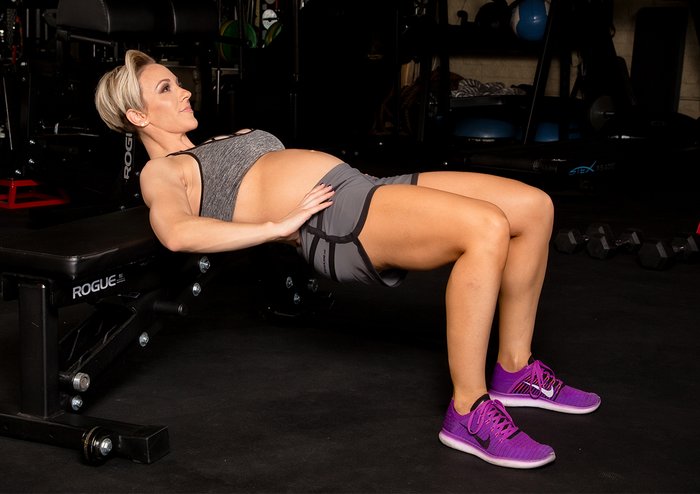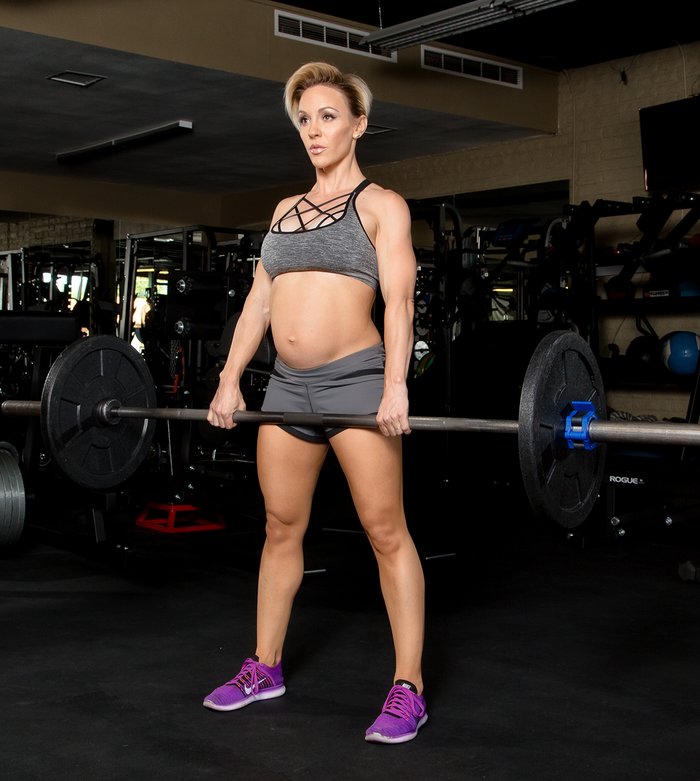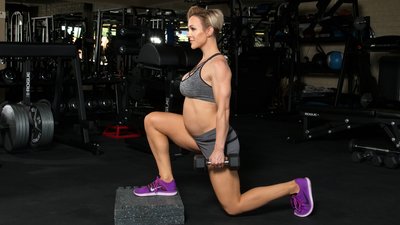Pregnancy is a time when most women sit up and take notice of their health, scrutinizing behaviors and habits for areas of improvement. You want nothing but the best for your baby.
The great news is if you were healthy and exercising regularly before your pregnancy, there is no reason you can't continue to exercise throughout—provided you have your doctor's approval.
The Benefits Of An Active Pregnancy
When done correctly and with your doctor's approval, physical activity during pregnancy may make you feel better and help you regain your pre-baby body faster once your little one arrives.
That said, you won't want to work out the same way you always have, especially as you move into the later stages of your pregnancy. With the added stress a growing belly puts on your body, some lifting modifications must be made.
Jessie Hilgenberg, who is currently pregnant with her second baby, is still hitting the gym strong.
"My main goal during this pregnancy was to keep my glutes!" says Hilgenberg. "I worked so hard to build this booty, I didn't want to lose it all!"
She notes that although she can't lift as heavy as she did pre-pregnancy, it's still totally possible to be a badass in the gym—if you know what exercises you can do.
Here are Hilgenberg's exercise recommendations while lifting for two.
Hip Thruster With Dumbbells
Hip thrusters are a popular choice for building glutes, but conventional hip thrusters with a barbell are rather difficult once that belly begins to grow.
"Once you get bigger, you obviously can't put a bar across the place you normally would during hip thrusters," Hilgenberg explains. "My modification is to use dumbbells instead, placing them on each hip bone while you perform the hip thrust."

To set your glutes on fire, try different sets with your feet in neutral position, wide stance, and narrow stance.
"Another option is a single-leg hip thrust, which you can do with the same dumbbell modification," she says.
Banded Hip Abduction
"I like to do these with my hips low using high reps," says Hilgenberg. "These really target your glutes!"
Lie on your side on a bench, being sure to support your lower back and belly. Hilgenberg recommends placing the band right below your knees.
"Make sure you squeeze your glutes at the top of the movement," she says, "and maintain tension on the muscles by lowering slowly back to the starting position."
Squeezing your glutes at the top helps you derive a better mind-muscle connection and ensures you feel the burn on every single rep.
Weighted Frog Pump
If you've never done weighted frog pumps, now is the time to start! The frog-legged position is great for targeting the glutes. As with the hip thrusts, you can add weight by placing dumbbells on either hip.
If you are far along in your pregnancy, you'll want to use a bench or hip-thrust station so you're off the floor. Place your feet so your soles face each other. Lift your hips up, the same as you would for a hip thrust, and squeeze at the top of the movement.
Do these a few times a week and you will feel and see a difference in your glutes. This will help you maintain your posture and core strength.

Pull-Through
The pull-through is another popular exercise for building full, strong glutes. You can include it in all phases of your pregnancy-lifting routine.
"With the pull-throughs, my stance is extra wide and my toes are pointed outward to make room for my belly," says Hilgenberg.
You'll want to make sure your hips slide back and forth as they hinge rather than just moving your torso up and down. Keep your back straight, your knees steady, and your shins vertical—this is a deadlift motion, not a squat!
Focus on squeezing your glutes the entire way through to better feel that mind-muscle connection.
Single-Leg Deadlift
Single-leg deadlifts are another great glute builder—and relatively easy to modify for pregnancy. Once again, you won't use a bar since your belly will get in the way.
"A fantastic alternative for single-leg deadlifts are hex-bar deadlifts or dumbbell deadlifts, if your gym doesn't have a hex bar," says Hilgenberg.
If you are further along in your pregnancy, reduce the strain on your lower back by using a staggered stance to create an effect similar to the strict single-leg stance.
"In the staggered stance, 80-90 percent of your weight should be in your front foot," explains Hilgenberg. "Focus on lifting through your front leg. Keep your front shin vertical as you let your knee slightly bend throughout the entire movement."
Hilgenberg also notes that you should engage your lats and focus on the hip slide.
"Instead of going up and down with your torso, think of your hips sliding forward and backward," she says.
Conventional Deadlift
"I use the Hex Bar because it has handles that are a little higher and it allows me to grip to the sides, which makes room for my belly," explains Hilgenberg. "Doing so allows me to continue to work on my conventional deadlifts, while giving me a little more room."
Hilgenberg focuses on engaging her lats and keeping her spine rigid when she lifts to keep her strong. This is one exercise that gets harder the further you get into pregnancy.

"I have to be super intentional when it comes to keeping my shoulder blades back and down, engaging my lats, and making sure my spine position is correct," says Hilgenberg.
The deadlift is a staple of any strength-building program, and it's one to keep in your routine if you can still perform it safely during your pregnancy. That said, you must keep your form in check and listen to your body. Don't load too much weight on the bar—this causes additional unnecessary strain on your back, and now is not the time for injury.
"To maintain the right position, I keep my weight in my heels as the extra baby weight up front makes me want to tip forward," says Hilgenberg.
Hilgenberg credits staying fit through pregnancy for the mental and physical stamina that helps her keep pace with her toddler as her family continues to grow.


